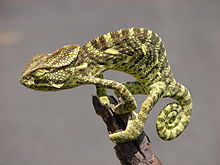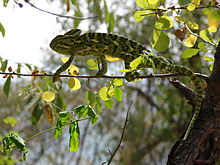- Chamaeleo zeylanicus
-
Indian Chameleon 
Scientific classification Kingdom: Animalia Phylum: Chordata Class: Reptilia Order: Squamata Suborder: Lacertilia Family: Chamaeleonidae Genus: Chamaeleo Species: C. zeylanicus Binomial name Chamaeleo zeylanicus
Laurenti, 1768The Indian Chameleon, Chamaeleo zeylanicus is a species of chameleon found in Sri Lanka, India and other parts of South Asia. Like other chameleons, this species has a long tongue, feet that are shaped into bifid claspers, a prehensile tail, independent eye movement and the ability to change skin colour. They move slowly with a bobbing or swaying movement and are usually arboreal. Strangely, they do not choose the background colour and may not even be able to perceive colour differences. They are usually in shades of green or brown or with bands. They can change colour rapidly and the primary purpose of colour change is for communication with other chameleons and for controlling body temperature by changing to dark colours to absorb heat.[1][2]
Contents
Distribution
They are found in India, South of the Ganges river. Type locality: Sri Lanka, restricted by Mertens in 1969.
Description
The head has a bony casque, ornamented with crests or tubercles. A separation between the eyes, the interorbital septum, is present. Pre-maxillary extremely small, edentulous; orbit bony all round, the pre- and post-frontals often joining to form a supraorbital roof; a pair of supra-nasal fontanelles, bordered by the nasals, the prefrontals, and the frontal; the latter bone single; parietal single, often much narrowed and compressed, forming a crest, and meeting posteriorly the extremities of the squamosals. Dentition acrodont; teeth compressed, triangular, more or less distinctly tricuspid. Palate toothless. Eye large, covered by a thick granular lid pierced with a small central opening for the pupil. No tympanum or external ear. Body compressed; neck very short. Vertebrae procoelian. Abdominal ribs present. Limbs long, raising the body. Digits arranged in bundles of 2 and 3; in the hand, the inner bundle is formed of three, the outer of two digits; it is the reverse in the foot. Tail prehensile. Head and body covered with granules or tubercles.
Casque much elevated posteriorly, with strong curved parietal crest; the distance between the commissure of the mouth and the extremity of the casque equals or nearly equals the distance between the end of the snout and the hinder extremity of the mandible; no rostral appendages; a strong lateral crest, not reaching the end of the parietal crest; an indication of a dermal occipital lobe on each side, not reaching the parietal crest. No enlarged tubercles on the body; a feebly serrated dorsal crest; a series of conical tubercles form a very distinct crest along the throat and belly. Male with a tarsal process or spur, Tail longer than head and body. Gular-ventral crest white; commissure of the mouth white.[3]
From snout to vent 7 inches long with a prehensile tail of 8 inches.
Notes
- ^ Walton, B. M. and A. F. Bennett. 1993. Temperature-dependent Color Change in Kenyan Chameleons. Physiological Zoology 66(2):270-287 [1]
- ^ Durve, V. S and H. S. Sharma. 1975. Some observations on color changes of the Indian chameleon. J. Bombay Nat. Hist. Soc. 72:107-112.
- ^ Boulenger, G. A. 1890 Fauna of British India. Reptilia and Batrachia.
References
- Barry, A.T. 1936 The Common Chamaeleon (Chamaeleon zeylanicus) in Gujarat J. Bombay Nat. Hist. Soc. 38: 201-202
- Gray,J. E. 1865 Revision of the genera and species of Chamaeleonidae, with the description of some new species. Proc. zool. Soc. London, 1864: 465-479.
- Laurenti, J. N. 1768 Specimen medicum, exhibens synopsin reptilium emendatam cum experimentis circa venena et antidota reptilium austracorum, quod authoritate et consensu. Vienna, Joan. Thomae, 217 pp.
- Singh, L. A. K. (1979): To change is chameleon. Science Reporter, 16 (1) : 59-61.
- Singh, L. A. K., Acharjyo, L. N., Bustard, H. R. (1984) : Observation on the reproductive biology of the Indian chameleon, Chamaeleo zeylanicus (Laurenti). J.Bombay nat. Hist. Soc., 81(1) : 86-92.
- Singh, L. A. K. (1986): The Indian chameleon, Chamaeleo zeylanicus (Laurenti) in Satkoshia Gorge Sanctuary, Orissa : Notes on availability, growth and biometrics. J.Bombay nat.Hist. Soc., 83(1), 111-119.
External links
Categories:- Reptiles of India
- Reptiles of Sri Lanka
- Reptiles of Pakistan
- Chameleons
Wikimedia Foundation. 2010.

